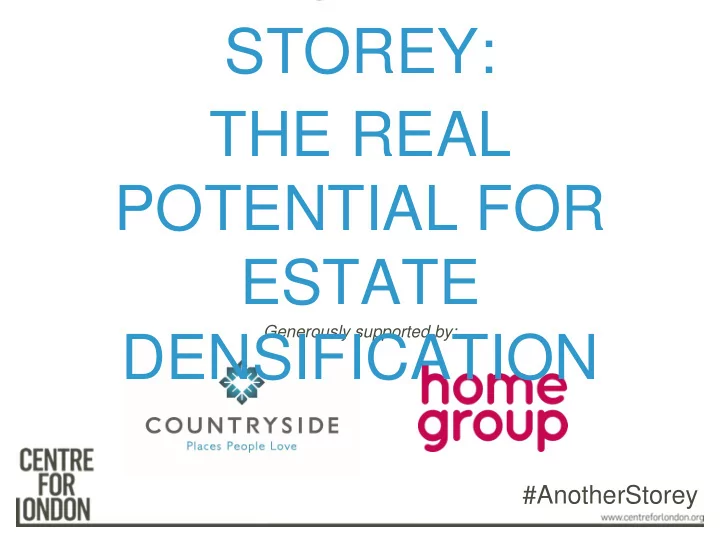

ANOTHER STOREY: THE REAL POTENTIAL FOR ESTATE Generously supported by: DENSIFICATION #AnotherStorey
ANOTHER STOREY: THE REAL POTENTIAL FOR ESTATE DENSIFICATION Kat Hanna and Pete Redman 29 September 2016 Generously supported by Countryside Properties and Home Group. #AnotherStorey
ANOTHER STOREY: CONTEXT What do we know about the existing densities of London’s estates, and what capacity do they have for densification? What factors affect the public and private sector costs, and what does this mean for the financial viability of estate densification? ##AnotherStorey #AnotherStorey
ANOTHER STOREY: POLICY CONTEXT #AnotherStorey
ANOTHER STOREY: POLICY CONTEXT #AnotherStorey
ANOTHER STOREY: METHODOLOGY 1. Identified sample of four London boroughs: Barking and Dagenham, Hounslow, Lewisham, and Waltham Forest. 2. Calculated densities of large estates (comprising at least 200 dwellings). 3. Compared estate densities to their ward densities in order to test scope for densification. 4. Projected the scope for densification beyond the limits of neighbourhood densities using London Plan density matrix. 5. Calculate uplift (in number of homes) on estates in these four boroughs if densified to SRQ ‘urban’ and ‘central’ levels. 6. Estimated London uplift range through estate densification. #AnotherStorey
ANOTHER STOREY: FINDINGS Estates are not particularly low density when compared with surrounding wards. #AnotherStorey
ANOTHER STOREY: FINDINGS All sample boroughs apart from Waltham Forest could meet up to half of their ten-year additional homes target through estate densification. #AnotherStorey
ANOTHER STOREY: FINDINGS Estate densification could add between 4,000 and 8,000 homes to London each year – up to 20 per cent of London’s annual additional homes need. #AnotherStorey
ANOTHER STOREY: FINANCIAL VIABILITY ASSESSMENT Base Case Two-hectare estate. 90 dpha (average London existing estate density). 180 dwellings. Densification model Doubled density to 180 dpha (20 per cent more than the London average density of new residential development of 153 dpha). 360 dwellings (including an increase in the number of affordable homes). 30 per cent low-rent/social-rent (55 per cent of the market rent), 30 per cent Affordable Rent (70 per cent), and 40 per cent shared ownership. No grants or subsidies. #AnotherStorey
ANOTHER STOREY: BASE CASE OUTCOMES Double the number of homes on the estate. Make better use of scarce land for housing. Increase the asset value of the estate by between 3 and 4 times. #AnotherStorey
ANOTHER STOREY: VARIABLES AFFECTING COSTS Tenure Mix at Initial Housing Values beginning Increase in Density Tenure Mix at Final Housing Values completion It is likely that returns will be maximised with higher density increases on Inner London estates in higher value locations. #AnotherStorey
ANOTHER STOREY: SUBURBAN LOW- DENSITY ESTATES Initial values were closer to final values. Density increases of more than double were unlikely to be appropriate or acceptable. Right-to-Buy sales could represent 70 per cent of the dwellings, far more than the London average. A subsidy required to make up the difference in local authority recovery costs. #AnotherStorey
ANOTHER STOREY: SUBSIDY SOURCES Sunk costs within the Social Housing Stock transfer local authority Assistance Central government Capital allocations Government loans grant to the authority Cross-subsidy #AnotherStorey
ANOTHER STOREY: HOME LOSS PAYMENT Base case Owners received £25,000 (10% of dwelling value). Tenant received £5,300 (set amount). By measuring the impact of decant in social value terms, we estimate a home loss value of between £15,000 and £20,000 per resident. There is a case for Homes Loss Payments for tenants to be increase three- or four-fold. #AnotherStorey
ANOTHER STOREY: RECOMMENDATIONS A full analysis of where London’s existing estates are, and their current densities, should be used to inform the next iteration of the London Plan. The Mayor should use this analysis to identify the potential for estate densification. Densification should not stop at the edge of housing estates. We recommend an approach that combines densification both of estates and other uses such as privately owned residential land and publicly held land such as car parks. Estate densification also needs to be carried out in a way that integrates the densified site with the surrounding urban fabric, adopting a mixture of block types and increasing in density nearer to urban centers and transport hubs. #AnotherStorey
ANOTHER STOREY: RECOMMENDATIONS Home Loss Payments should be increased to ensure the fair treatment of tenants in the demolition and densification process. There may also be a case for varying the amount depending on the number of years lived in the dwellings; its value; and whether the move is within or outside the estate. Where suburban, low-density estates are densified, this should be supported by a programme of gap funding if necessary. This could be through a combination of central government grant, housing association cross-subsidy, private finance through stock transfer, and local authority contribution. #AnotherStorey
Recommend
More recommend